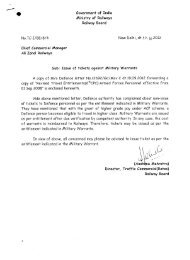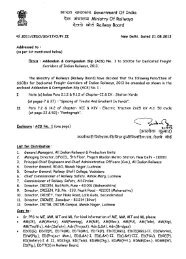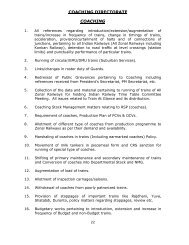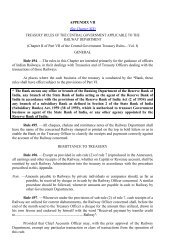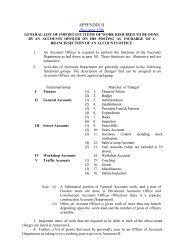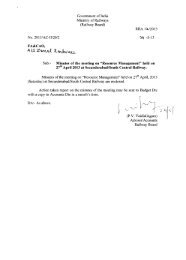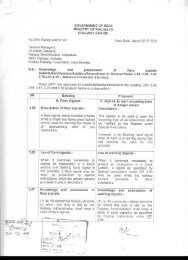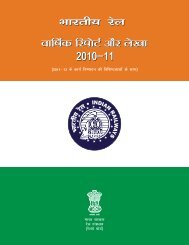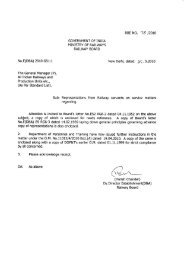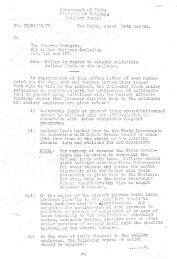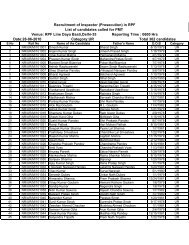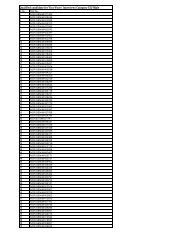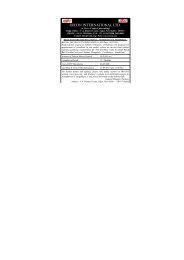chapter ix – telephone exchange & trunk exchange - Indian Railway
chapter ix – telephone exchange & trunk exchange - Indian Railway
chapter ix – telephone exchange & trunk exchange - Indian Railway
You also want an ePaper? Increase the reach of your titles
YUMPU automatically turns print PDFs into web optimized ePapers that Google loves.
CHAPTER IX<br />
TELEPHONE EXCHANGE & TRUNK EXCHANGE<br />
9.1 EXCHANGES :<br />
9.1.1 All Telephone Exchanges shall be<br />
* Automatic<br />
* Electronic<br />
* Digital<br />
* Stored Programme Controlled (SPC)<br />
* Pulse Code Modulation (PCM, Time Division<br />
Multiplexing (TDM) technology.<br />
9.1.2 The <strong>exchange</strong>s shall be Transit cum Local Exchanges providing connectivity between<br />
:<br />
* Subscriber to Subscriber<br />
* Subscriber to <strong>trunk</strong><br />
* Trunk to Subscriber<br />
* Trunk to <strong>trunk</strong><br />
9.1.3 Separate <strong>trunk</strong> Automatic Exchange shall be provided at Zonal <strong>Railway</strong> Headquarter<br />
for <strong>Indian</strong> <strong>Railway</strong>s Network. The transit functions at other places shall be integrated<br />
in the Local-cum-Transit Exchange.<br />
9.1.4 The manual <strong>trunk</strong> connections shall be provided through Operate consoles (Attendant<br />
Consoles). The Operator Console shall be an integral part of the Exchange. Separate<br />
manual <strong>trunk</strong> <strong>exchange</strong> are not required to be provided.<br />
9.1.5 Attendant Consoles :<br />
The attendant consoles which replaces the Trunk Boards shall be an integrated part of<br />
the <strong>exchange</strong>. This shall assist the <strong>trunk</strong> operator to provide Trunk connections.
Facility shall exist to monitor the calls. Busy indication of the <strong>trunk</strong> shall be available.<br />
Head phones shall be provided with Attendant console.<br />
9.1.6 Subscriber Telephone Set :<br />
All <strong>telephone</strong>s shall be push button type. The signalling may be decadic or DTMF<br />
type. The <strong>telephone</strong>s shall be of the following type :<br />
- Ordinary<br />
- Secretary and Executive type<br />
- Digital<br />
- Magneto<br />
- 4 wire<br />
9.1.7 The IR (<strong>Indian</strong> <strong>Railway</strong>) <strong>exchange</strong> network is a hierarchical architecture with 3 levels.<br />
Highest level - Zonal Head Quarters (ZHQ) and <strong>Railway</strong> Board (RB)<br />
Medium level - Divisional HQ (DHQ)<br />
Lowest level - Important activity centres<br />
9.1.8 The <strong>exchange</strong>s shall be interconnected using manual <strong>trunk</strong>s through Trunk Operators<br />
or through Subscriber Trunk Dialing (STD) channels. Where digital transmission<br />
system is planned, the ZHQ to DHQ and DHQ to important location <strong>exchange</strong> shall be<br />
connected through high speed 2 MB/s (30 channel) <strong>trunk</strong> groups.<br />
9.1.9 All <strong>exchange</strong> shall be available on IR STD network subjected to availability of<br />
channels. Each <strong>exchange</strong> shall have a distinct STD code. Alternate routing shall be<br />
provided as far as possible.<br />
9.1.10 Wherever possible interconnection to DOT <strong>exchange</strong> shall be provided through Direct<br />
Inward Dialing (DID) and Direct Outward Dialing(DOD) facility. The traffic for such<br />
<strong>trunk</strong> lines shall be taken as 0.8 Erlang/Trunk line and calculation of <strong>trunk</strong> lines shall<br />
be done accordingly.<br />
9.2 SPECIFICATION & PERFORMANCE PARAMETERS<br />
9.2.1 The digital <strong>exchange</strong>s shall be of the following basic capacity and shall be modularly<br />
expandable.<br />
128 port<br />
256 ports<br />
512 ports<br />
1024 ports
2048 ports<br />
4096 ports<br />
9.2.2 The <strong>exchange</strong> shall have ports to connect subscribers with<br />
Decadic phones<br />
DTMF phones<br />
Digital phones<br />
Hot line<br />
Long distance<br />
lead line through any media of communication<br />
- Trunk through all media of communication<br />
(O/H, Cable, VHF, UHF, MW, OF)<br />
- Attendant consoles<br />
9.2.3 2 MB/s or higher speed <strong>trunk</strong> ports shall be planned in the <strong>exchange</strong> for high speed<br />
connectivity between <strong>exchange</strong>s.<br />
9.2.4 The capacity of the <strong>exchange</strong> shall be defined with the following details :-<br />
- Wire Capacity<br />
- Equipped Capacity with<br />
. No. of subscriber ports- decadic/DTMF and digital phones.<br />
. No. of long distance subscriber, <strong>trunk</strong> ports with various type of<br />
signaling<br />
. 2 MB or higher speed <strong>trunk</strong> port.<br />
. Ports for attendant console<br />
9.2.5 The Architecture of the Exchange shall be with the following protection arrangement.<br />
a) Up to 128 ports<br />
CPU and control cards -1 + 0 Configuration<br />
Memory -1 + 0 Configurations<br />
Power supply unit -1 + 1 hot Stand By (S/B)<br />
b) Exchange with capacity higher than 128 ports<br />
CPU and control card -1+1 hot Standby configuration & hot swappable<br />
Memory -1+1 hot Standby configuration & hot swappable<br />
Power supply card -1+1 hot Standby configuration & hot swappable<br />
9.2.6 The <strong>exchange</strong> shall be fully non-blocking.<br />
9.2.7 The minimum BHCA (Busy Hour Call Attempts) for <strong>exchange</strong> shall be as follows:-
Up to 128 port = 20,000<br />
Above 128 up to 256 port = 50,000<br />
Above 256 up to 512 port = 1,00,000<br />
Above 512 up to 1024 port = 1,50,000<br />
9.2.8 The <strong>exchange</strong> software shall be loaded on hard disc or flash RAM for operation as<br />
well as a back up copy must be available.<br />
9.2.9 The software must have self diagnostic feature and the failure must be available as<br />
print out.<br />
9.2.10 The basic requirements of the protective device provided on MDF shall be as<br />
under :<br />
i) The device shall not operate on speech or signaling currents.<br />
ii) It shall not decrease the efficiency of speech or signaling circuit.<br />
iii) The device shall promptly operate in cases of the specified voltages or<br />
currents being reached.<br />
iv) The device shall promptly isolate the equipment and prevent further<br />
damage in cases of overload due to artificial or natural causes.<br />
v) The current rating of the device shall be such that they do not produce<br />
noticeable heat in the components of the main equipment.<br />
vi) The device shall prevent transient discharges which would normally injure the<br />
audio system of the listener.<br />
vii) The device shall be as far as possible self restoring type.<br />
viii) The prospective devices shall consist of fuse & lightning discharger. The fuse<br />
shall be connected in series with each external line.<br />
<strong>ix</strong>) The Integrated Protection Modules shall be provided in case of Krone type<br />
connectors.<br />
x) The rating of the fuse shall be as per the requirement of <strong>exchange</strong> equipment.<br />
xi) The Protection arrangement shall be installed on IDF or MDF.<br />
xii) The subscriber’s protective device assembly shall consist of a single compact<br />
dust proof unit containing fuse and lightning arrester.<br />
9.2.11 The Signalling used shall be :<br />
i) User line signalling * Decadic dc loop/disconnect signalling<br />
* DTMF signalling<br />
* D-Channel protocol (ISDN)<br />
ii) Inter Exchange * 4W E&M<br />
Signalling * 4W digital (64 kbs)<br />
* DC - loop/disconnect signalling<br />
* R2 MFC (<strong>Indian</strong> version)<br />
* CCITT Signalling system No.7<br />
(Common Channel Signalling)<br />
* Q-Sig for feature transparency
9.3 SYSTEM REQUIREMENTS<br />
9.3.1 The various components of the <strong>exchange</strong> system shall be<br />
a) Exchange hardware<br />
b) Exchange software<br />
c) Man Machine Interaction Terminal PC with Printer<br />
d) Test and measuring instruments<br />
e) Power supply Arrangement consisting of Batteries, Charger, Changeover<br />
panel and stand-by system.<br />
f) Intermediate Distribution Frame<br />
g) Main Distribution Frame<br />
h) Protection arrangement<br />
i) Attendant consoles<br />
j) Cable (underground and switch board)<br />
k) Subscriber <strong>telephone</strong> set<br />
l) Maintenance tools<br />
m) Documentation<br />
n) Lightning protection and Earthing arrangement<br />
9.3.2 The man machine language must be in English and user friendly. A VDU, keyboard<br />
and a printer alongwith a PC must be available for interaction with the Exchange.<br />
9.3.3 The <strong>exchange</strong> shall be worked with batteries on float. The capacity of the batteries<br />
shall be to provide minimum 8 hours back up. One set of battery, two chargers and a<br />
change over panel are to be provided for supplying power supply to <strong>exchange</strong>. The<br />
capacity of power supply arrangement shall be 30% higher than the <strong>exchange</strong> load.<br />
The charger shall be preferably SMPS (Switch Mode Power Supply) type.<br />
9.3.4 The IDF (Intermediate Distribution Frame) shall have disconnecting type connectors<br />
with facility for isolating <strong>exchange</strong> indoor and outdoor side. The cable terminals shall<br />
be installed on a rack. Protection arrangement shall be available on IDF. All testing<br />
for line side shall be done from IDF. The IDF may be accommodated in <strong>exchange</strong><br />
equipment room.<br />
9.3.5 All outdoor cable shall be terminated on a rack forming the Main Distribution Frame<br />
(MDF). This shall provide connectivity between outdoor cable and indoor switch<br />
board cable. The Main Distribution Frame shall be installed in a separate room but not<br />
in the <strong>exchange</strong> room. An earth is connected across the frame for its entire length and<br />
preferably this shall be a copper strip clamped to the frame.<br />
9.3.6 Cables:<br />
The outdoor cables shall be jelly filled underground type. The indoor cables shall be<br />
switch board cables. The outdoor cables shall be 20 pair, 50 pair and 100 pair<br />
capacity. The indoor cable shall be 5 pair, 10 pair, 20 pair and 50 pair.
The outdoor cable shall have outdoor Termination Box/Location Box with terminals<br />
for proper termination of the cable. The indoor cable shall be terminated on CT boxes<br />
of appropriate size. The cables, cable Terminals in CT Boxes shall be planned with<br />
30% spare capacity. All outdoor cable sheath shall be earthed while entering the<br />
<strong>exchange</strong> at MDF.<br />
9.3.7 Lightning protection and Earthing arrangement<br />
The earthing arrangement shall be consisting of<br />
- Earth pits minimum four with Earth electrodes connected in a ring<br />
- Two earth wires connecting Earth Electrodes to Earth Distribution Frame<br />
- Earth wires from each equipment to Earth Distribution Frame<br />
(Exchange rack, IDF, MDF, Charger, Battery, Gen set, Power panel, Cables)<br />
9.3.8 Civil Infrastructure:<br />
The <strong>exchange</strong> room shall be dustproof, with false ceiling, mosaic flooring, windows<br />
with double doors, underground duct or overhead trough for running of indoor cables.<br />
Separate Operator Console room, Power supply room, Battery room, DG set room ad<br />
MDF room shall be provided. Floor should be strictly level and high enough to avoid<br />
flooding.<br />
9.3.9 Electrical Supply :<br />
230 V AC single phase shall be available. With power lines suitable for taking the<br />
load, Alternate supply shall be provided either traction supply or DG set. The power<br />
supply shall enter the room through MCB and changeover switch with proper earthing<br />
arrangement.<br />
9.3.10 The <strong>exchange</strong> equipment room shall be air conditioned. 22-25 degree C. shall be<br />
maintained inside the room. 50% standby air conditioners shall be provided.<br />
Lightning shall be adequate for maintenance.<br />
9.3.11 All equipment shall be provided on racks. Mounting on the walls shall be avoided.<br />
The equipment rack shall be minimum 1 meter away from the wall. The racks shall be<br />
f<strong>ix</strong>ed on the floor with proper arrangement. Underground ducts shall be provided for<br />
entry of UG cables. Duct/overhead troughs shall be provided to run the indoor cables.<br />
In case of UG cable entry the duct shall be filled with sand and plastered on the top.<br />
9.4 MAINTENANCE<br />
9.4.1 PREVENTIVE MAINTENANCE<br />
A) Daily<br />
i) Batteries voltage and charger output voltage.
B) Weekly<br />
C) Monthly :<br />
ii) AC supply voltage and charger output voltage.<br />
iii) Cleaning of equipment rooms with vacuum cleaner and wiping of the<br />
floor for all rooms.<br />
iv) Failure list of the subscribers.<br />
v) Testing of all the <strong>trunk</strong>s (STD,OTD and other) circuits.<br />
vi) Working of Lights, Air conditioners.<br />
vii) System status listing<br />
viii) Failure history list<br />
<strong>ix</strong>) Alarm checking<br />
x) Room temperature recording<br />
i) Specific gravity, voltage and load test of the batteries, sulphation of<br />
terminals.<br />
i) Wiring and connecting terminals of power supply arrangement.<br />
ii) The different modes of operation of FCBC, the internal checking and<br />
cleaning of FCBC.<br />
iii) Earthing connections of all equipment and earth electrodes.<br />
iv) All cabinets of equipment, Man machine interaction, terminal printer,<br />
attendant consoles to be cleaned.<br />
v) Cable termination MDF and IDF to be cleaned and checked.<br />
vi) Cable runs-inter rack, rack to IDF, MDF and Attendant consoles to be<br />
checked.<br />
vii) Transmission loss test of all <strong>trunk</strong> circuits<br />
viii) Office Data Back up to be updated.<br />
<strong>ix</strong>) Checking of GD tubes<br />
x) Functional Testing of Attendant console<br />
xi) Tone testing of MW circuits & realignments<br />
xii) Traffic data listing & analysis<br />
D) Quarterly :<br />
i) Contact points of Attendant console to be cleaned with contact cleaner.<br />
ii) Testing of All Service features from the Test Telephones.<br />
iii) Cleaning of terminations in CT boxes, Location boxes.<br />
iv) Adjustment of SMPS modules<br />
E) Yearly :<br />
i) Earth resistance value measurement<br />
ii) Line loop resistance and insulation testing<br />
iii) Checking of wiring of subscribers premises, CT boxes and location boxes.<br />
iv) Testing of spare cards<br />
v) Analysis of load distribution among operators console<br />
vi) System programme backup
9.4.2 Inspection :<br />
The following are the details to be checked during routine Inspection.<br />
a) Subscriber’s office<br />
i) CT boxes<br />
ii) Wiring<br />
iii) Lightning arrester<br />
iv) Batteries/power supply arrangement<br />
b) Cables/overhead alignment<br />
i) Type of cable and length<br />
ii) Cable route conditions with special attention at culverts, bridges, road<br />
crossings, track crossing, building entry points.<br />
iii) All registers pertaining to cable laying, testing<br />
c) Exchange<br />
i) MDF/IDF wiring, connectors, terminals, fuses, GD tubes.<br />
ii) Earth connections, Earth readings.<br />
ii) Power supply arrangement, battery registers, battery terminals, wiring,<br />
charger and power panel.<br />
iv) Internal cabling, cabinets, visual inspection of wiring.<br />
v) Fault register<br />
d) Periodical Inspection<br />
i) All <strong>exchange</strong>s and other <strong>telephone</strong>s installations shall be inspected and<br />
tested, where necessary, by ASTE/DSTE/Sr.DSTE at least once a year.<br />
Maintenance records and faults registers shall be checked for their<br />
proper upkeep.<br />
ii) Sr. Section Engineer Telecom should carry out detailed and effective<br />
inspection and testing once in a quarter year and Junior Engineer(Tele)<br />
once in a month.<br />
9.4.3 Testing and Commissioning :<br />
i) Cable/overhead line testing shall be conducted for each subscriber.<br />
Insulation, loop resistance for cable/OH line is to be tested and<br />
recorded.<br />
ii) Provision of fuses, GD tubes are to be checked for all lines.
9.4.4 Documentation :<br />
iii) The earth resistance for each earth electrode is to be measured. The<br />
connectivity of earth wires to each equipment is to be checked.<br />
iv) Hardware testing shall be conducted as per instructions of<br />
manufacturer.<br />
v) Software testing shall be done as per guidelines given by supplier.<br />
The <strong>exchange</strong> shall have the following documentation :<br />
a) Indoor Equipment<br />
- Exchange layout plan<br />
- Rack layout plan for each rack with connection details<br />
- MDF and IDF termination plan<br />
- Installation manual for equipment<br />
- Software documentation<br />
- Operation and maintenance manual<br />
- Wiring diagram for power panel<br />
- Manual for chargers<br />
b) Outdoor Equipment :<br />
- Telephone No. wise subscriber’s details<br />
- Subscriber wise Telephone Directory<br />
- Cable/Overhead layout plan<br />
- Subscriber premises wiring plan typical.<br />
9.4.5 The tools available in <strong>exchange</strong> shall consist of<br />
- Screw drivers assorted<br />
- Nose Plier<br />
- Crimping tool<br />
- Krone Extractor<br />
- Cutter<br />
- Soldering kit<br />
9.4.6 The following test and measuring instruments shall be available in <strong>exchange</strong> for<br />
testing and maintenance<br />
* Line tester to test line conditions<br />
* Megger for testing of insulation of line.<br />
* Digital multimeter<br />
********



